Fairytale spot has magical memories
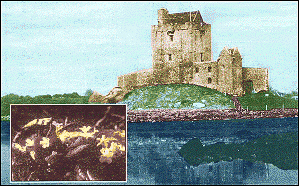 |
| GLORIES of Ireland: Dunguaire Castle and (inset) the primroses that grow in the wood nearby. |
A weekly appreciation of nature.
 |
BY the time you read this, I will once more be climbing the
stone steps to Dunguaire Castle (Dungoura) on Galway Bay.
It is only four weeks since I took this photograph but such is the magnetic
draw of the village of Kinvara, its people, the wild places and its wildlife.
At Easter I took all of my family, while this time it's my band
'
The Curragh Sons' and 30 faithful followers who
will descend upon the world famous Cuckoo Fleadh.
Admittedly, with five gigs in three days we are not likely to see much wildlife
this time - at least the kind with fur and feathers.
But let me take you back a few weeks, when I was taking in the view and
remembering all the school holidays I had spent in places like this.
The sun is going down on the castle, and the mute swan sailing towards me
could probably tell a tale far more eloquent than I, with echoes of Irish
legend when children turned into swans and men grow old if they ever dismount
their horse, but here goes.
Beyond the tower, where salt water fights with the outgoing fresh water to
create a frothy foam, which spreads across the brackish lagoon when the tide
is full, there sits a wood of strange proportions - no jokes please.
To the 'little people' who reputedly inhabit the wood, it is massive, but
to you and I, it is very small.
Now spare the ridicule, but tales of hazel woods inhabited by leprechauns
were the daily currency of my young summers in Ireland.
Most of the stories were beautiful, but if we stayed up too late, the Banshee
or the big black dog from the bog was likely to take us away.
Or if we were really naughty, the fairies would steal us in the night and
we would become 'changelings', complete with pointy ears and curly hair.
As I already had curly hair, I held on extra tight to the blankets, fearing
I would be first choice.
The hazel wood is full of intricate pathways which weave impossible mazes
in and out of the miniature trees, and the wonderful clumps of primroses
could surely have been planted by the fairies of Kinvara.
But hang on a minute, I'm a grown-up now - the pathways through the hazel
are made by foxes and other animals, and the clumps
of yellow flowers are growing there because it is the perfect habitat for
them.
As children, we never dared crawl into the maze, but at 48 in I went.
A tiny wren almost hopped off the end of my nose, while a male blackbird
whizzed past singing the most indignant song. I was
Gulliver in Lilliput.
There was a small clearing in the wood and a choice of about eight other
avenues to explore, so I headed for the direction of the sea.
After about 30 metres the trees became so dense it was necessary to force
my ample frame through the thicket, which obviously woke every other living
thing in the wood and wings clapped and birds sang as the feathered throng
got out while the going was good.
Just then I caught the unmistakeable whiff of a fox on the air - even poor
old Reynard had been disturbed by my actions.
As I crawled out of the wood and faced the bay, there was the fox, shaking
off his sleep and in turn disturbing all manner of wading birds, which had
obviously felt safe very close to the shore.
His presence was completely ignored by the 10 reptilian herons who carried
on their stealthy hunting without a pause, and within a minute he was gone.
It took more than 60 seconds for the waders to return, but there was no rush
- after all I had already waited 40 years to venture into a fairy wood.
If you would like to visit the wood I can tell you exactly where to find
it, as it is just down the road from the best B&B in the west, Dunguaire
House. Tap it in to the net and check
it out, but don't blame me if you come back with pointy ears!
Reflections on a wildlife paradise
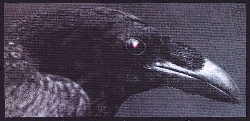 As predicted, there was not much time for bird watching on Galway
Bay last weekend, with my band performing five times in three days.
As predicted, there was not much time for bird watching on Galway
Bay last weekend, with my band performing five times in three days.
But even with such a hectic schedule of music-making, fur and feather flashed
by in myriad guises, enough to satisfy the weariest of balladeers.
Between gigs and pints of Guinness, and pints of Guinness and gigs, I was
struck by the sheer beauty of this place called Kinvara.
And I am not on my own, for the 30 guests we had taken with us thought for
sure that they had landed in paradise.
As we pulled up on the quayside, sunglasses were the order of the day and
kinetic flashes of light bounced from off the top of shore-bound wavelets,
fresh in from the Atlantic.
To greet us, a pair of mute swans sailed in to accompany the curvaceous Galway
hookers which leant lazily against the harbour wall, their sails furled for
the next tide.
The swan's nest sits on a rocky islet at the edge of the village, so close
that it was possible to watch the bird's complete nesting habits from the
side of the road.
First she moved the eggs gently with her bill, then she gracefully settled
in for a round of incubation, and then when the heat became too much in the
middle of the day, the incumbent swan spread one wing out in a protective
fan to preserve the precious charges.
The swans, of course, were silent, hence the name, but the village rookery
which presides over the Convent School made enough noise to wake the dead.
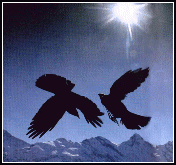
I am obviously very strange because I find the cawing and high-pitched
chirrups which accompany the high rise life of these crows extremely
evocative.
This was especially true early one morning, when on the still air the sound
carried on out across the bay and was only interrupted by the harsh call
of the kinvara herons.
Some of our guests were similarly serenaded by early morning cuckoos, a
delightful addition to the dawn chorus, especially as we were attending the
world famous Cuckoo Fleadh.
Several lucky diners were also treated to the sight of a
fox in all of its pomp strutting across the fields
while they ate breakfast.
He even stopped to 'do his business' as they were half way through their
'full Irish' - thankfully no one was put off by the vulpine ablutions.
Readers will have realised by now that the Cuckoo Fleadh is very special
to me, not least because it combines my twin passions of wildlife and Irish
music.
But I have now taken my love the place, and the west in general, one step
further by releasing a CD my poetic musings called 'The Cuckoo Set Fair For
Altca'.
The CD was launched last week by poet and novelist Fred Johnson Galway, who
kindly contributed the sleeve notes as well, and I was humbled by the
response.
Other poets present commented on the '...more than usual sensitive to the
landscape, flora and fauna'.
Personally, I view the writing as an extension of this column and therefore
wildlife and wild places certainly figure prominently in the work. However,
there is also a great deal of autobiographical material interwoven throughout.
This extract is taken from Oilean Maisean on the CD:
Today, down comes the boat in painterly fashion,
Set on the sand for my canvas and I.
Friends who stay,are dazzled by purity,
Whilst the red -backed hare hides the hungry rocks,
And splashes through the Beaker pools of hasty hearths,
Washed clean each day, as lunar hands guide a bird in flight,
And the heat of sun allows sedge and hawk,
To dally at the edge of my world.
Copies of the CD which runs for 30 minutes are available directly from
myself at £5 plus 50p post and packing - check out details on the band
website at
http://www.homestead.com/curraghsons/index.html
[The Advertiser May 16 2002]
Carrion
And so the crow comes
To take out my heart
Revealed from exposed flesh
Peeled back by the vultures
Ravenous at my bones
Tearing limb from limb
In a savage feast
Music has no charms to sooth them
These savage beasts
There's no terror in this pillory
The black winged saviour
Keeping the last vestige
In the ivory tower
Away from prying eyes
Away from eagles
Away from wolves
Flying to Brazil
An alien heart ripped apart and carried
On blackened quill
My body left as carrion
Mind and thoughts
For vicarious thrill
I am the antidote
And free from bondage
My reddened pumping vessel
Taken from an exposed ribcage
The whales do not weep for me
The harpoon has long since
Drilled into my soul
All my life dripped red into the soil
Fly free red vessel
Anywhere,anywhere
but here
Lee
[More
Poems]
It's a batty world for mega-moths
EVERY now and then, my worlds collide and it is no bad thing
when they do, especially if it involves Guinness,
Ireland and wildlife.
Sing the praises of our Skylarks
|
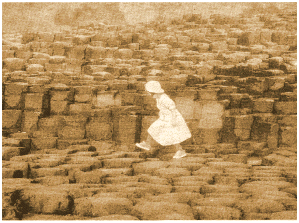 |
VAN 'the man' Morrison wrote a beautiful song about a 'Sense
of Wonder' and if ever a picture I have taken illustrates what he meant,
then this little girl taking giant steps across the
Giant's Causeway in
Northern Ireland is
it.
With a veritable skip in her step and a smile on her face, the Crown Jewels
and half a ton of ice cream would not have prised her away fnom the basalt
marvel. Whereas for me, the promise of lobster, soda bread and a night on
the Guinness was enough to tempt me back to the car after 20 minutes. However,
I would like to think that I have retained the girl's sense of wonder and
greatly admire those adults who have managed to cling to that part of their
life.
It is a kind of Captain Cook curiosity crossed with Gabriel Oak candour,
and a dash of unsullied innocence thrown in for good measure. Tall order
for a 51-year-old, l8st proip forward? Not on your Nelly.
David Bellamy has it, Richard Attenborough by the bucket-load, and this morning
I was diving right into my own supply, at the sight of two short-eared owls
sharing their early morning field vole in fmnt of me.
It was 7.30am, and a cool mist still hung in necklaces around the small conifer
plantation as I began. to climb the Holme Moss road. I knew the owls were
nesting nearby and as I placed what was left of my toast on my lap, I was
excited. Teaching was an age away (two hours actually) and life does not
get any better. A double take saw me face to face with one adult owl perched
on a fence post. It was no use. stopping opposite the bird, no matter how
tempting, because it would just fly off, so I pulled up gently about 30-40
ft further on and reached for the binoculars.
So close did the binoculars take me to the owl, his yellow eyes, lit up the
optics, and all thoughts of work were forgotten.
Two further cars and a noisy motorcyle later saw the bird lift oft towards
the moor. But the show was not over, and another adult lifted from the rough
tussocks in an attempt to share the short-tailed field vole which was swinging
from the first bird's undercarriage. After a minute or two of aerial combat
and the momentary interference of a passing kestrel, my morning display had
lasted no more than five minutes, but the desultory flight of these long
winged, and day-time flying owls,will last a lifetime.
Continuing on my way to Ashton the world was, and is a wonderful place. I
am sure people think, 'what is he on?' But as I sat there with my bacon and
tomato on toast, the world was once again my oyster and when the kids walked
in, Woody was smiling.
From your many communications, readers share the aforementioned sense of
wonder and that wide-eyed tadpole in the jar joy, so cheers to you all. The
little girl on the legendary Giant's
Causeway, is a metaphor for the amazing things all around us, so, please,
never stop looking.
Links RSPCA | IFAW | Animal Planet | MAFF | Badger | Bear | Fox | Castle | Magpie | Cryptozoology | |
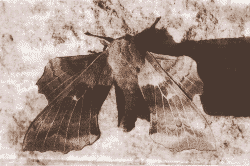
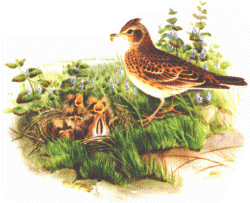 IN MY young days, (you know, old money days, long before such things
as kilos), skylarks were a constant summer companion, and their soaring song
was only matched by their soaring flight above the farmlands of Leicestershire.
Unfortunately, and unknown to me when I moved to Scotland in 1971,the rot
had already set in for the skylark, due to a change in farming practice.
From around 1970 the change from spring to winter cereals, as well as intensified
grassland management rapidly affected the success of this ground-nesting
bird.
IN MY young days, (you know, old money days, long before such things
as kilos), skylarks were a constant summer companion, and their soaring song
was only matched by their soaring flight above the farmlands of Leicestershire.
Unfortunately, and unknown to me when I moved to Scotland in 1971,the rot
had already set in for the skylark, due to a change in farming practice.
From around 1970 the change from spring to winter cereals, as well as intensified
grassland management rapidly affected the success of this ground-nesting
bird.